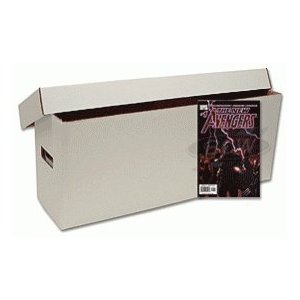Super Paper Doll Saves the Day! Organizing Comic Book Collections
Comic books. Graphic novels. Whatever you call them, and whether they’re kept for sentimental reasons or investment purposes, they’re definitely not kid stuff.
Organizing comic books involves two separate but equally important elements, physically organizing the actual books and maintaining an informational database so that you know what you have, where it’s kept, and the features that determine the value.
PHYSICAL ORGANIZATION
1) Handling comics
I may sound like your mother (or Paper Mommy), but washing your hands removes surface oils, preventing damage to the covers or pages. Serious collectors might even want to try the white glove treatment. Handle comic books by the open edges of pages rather than the spines or stapled edges. Avoid fully opening thicker books, which creates stress marks and creases on the spine.
2) Storing comics
Archival products exist specifically for organizing comic books:

Boxes — Collectors prefer archival-quality, acid-free cardboard boxes in one of two sizes. The first, called Long Boxes, are 27.25″ long by 7.5″ wide by 10.8″ high, and hold approximately 300 comic books. Short Boxes are 15.75″ long by 7.5″ wide by 10.75″ high, and hold about 100 comic books.
Mylar Sleeves — These bags are considered the container of choice for individual comics. If you’re just trying to maintain a tidy collection, with no anticipation of keeping comics for investments, the sleeves aren’t essential. However, because they do keep dust, dirt and moisture away from the comics, mylar sleeves are superior to other alternatives. They come in two sizes: the smaller 6 7/8″ by 10.5″ fit standard-sized comic books, while larger books, like graphic novels and annuals, should be contained in 8″ by 10.5″ sleeves.

Backboards — Comic book aficionados use boards between vertically-stored books to prevent damage to the corners, edges and spines. For archival purposes, the boards should be acid-free; most are manufactured this way but degrade over time.
For shorter-term storage purposes (i.e., less than five years), collectors can buy boards with 24-point solid bleached sulfphate coating on one white side, against which the book rests. For longer-term storage, collectors prefer virgin, alkali-buffered backboards. Put the book on top of the board, and slide the book/board combo into the mylar sleeve.

Divider boards are used to divide sets of titles. The name of each title or series should be written (or affixed with tapes printed by label makers) on the index tabs of the dividers.
Storage conditions are crucial. Humidity, extreme heat and bright sunlight are like kryptonite to comic books. Create a bat cave for your comics — keep them dry (in 50-60% relative humidity), cool (preferably at 70 F or below) and away from direct sunlight (and preferably, in a dark storage space). Avoid storing collections in basements or near pipe-bearing walls to lessen the risk of water damage.
Be sure not to pack comics too tightly together. Doing so won’t merely squish the books, potentially damaging the pages, spines, and corners. Tightly packed comic books, like overstuffed filing cabinet drawers, will make you reluctant to put away newer acquisitions, leaving them open to the elements, more likely to become damaged and disorganized.
3) Supervising your collection
If you collected fine china figurines, you’d make time to dust your collection and inspect it for damage. You need to check your comics, too, to make sure they show no signs of mold, mildew, fading, bleeding or color transfer.
4) Organizing your comics
There are two general options:
Organize meticulously, such as alphabetically by sub-collection (e.g., each Marvel superhero) and then chronologically by issue date or issue number.
OR
Organize loosely, perhaps by date of acquisition or by no feature at all, but carefully index exactly what comics are in which boxes, at which positions.
Surprised by the second option? Zam! Pow! I’m a bit shocked to suggest it, but as I researched this topic, I found that comics have much in common with the current discussion among professional organizers regarding organizing email and electronic files. While many of us still believe in creating specific folders and sub-folders and keeping similar items together, other organizers follow the notion that search, rather than system, should be the focus.
Organizing by individual collection intuitively makes more sense, because all items of a particular type (like Spiderman issues from 2000-2010) are immediately accessible. However, if you have a large collection, this involves filing away each item in the appropriate box. It also involves creating a box numbering system which can get complex if you overflow box 6 with S (Silver Surfer, Spiderman, Superman, etc.) but box 7 already has T-starting comics. Such a numerical system would yield Library of Congress or Dewey Decimal complexity fairly quickly.
Conversely, though I’m loathe to suggest it, simply storing newly acquired books and logging them in an indexing system (so that their exact placement requires only a quick keyword search for retrieval), is probably the wave of the future.
CATALOGING AND INDEXING
A basic spreadsheet can be used to keep track of your collection. It may suffice to merely track the title, issue number, and box number or location. However, if you’re going to make the effort to design a database, create columns for a variety of data points or key tags, including:
Publisher
Series
Title/Subtitle
Main character
Second characters
Publication date
Issue number
Price paid
Estimated value for insurance purposes
Location (Physical location in house/office, box number and position)
Condition
Comments (regarding condition, acquisition history, etc.)
Once you’ve created your database spreadsheet, you’ll be able to use the Filter and Sort functions to search by specific parameters. It also makes sense to create a header row and use “freeze headers” so that when you scroll up and down (or to the left and right), the informational headers will remain in place, limiting confusion when you’re entering information in cell DD837.
Keep backups on flash drives, external drives and/or in cloud solutions (like Dropbox). If your collection has significant value, keep a digital or paper copy of the updated information in your safe deposit box or fireproof safe for insurance purposes. To navigate your collection quickly, keep a printed index near your collection boxes.
If you’re serious about your comic book collection, investigate the various digital database options available, whether via software installed on your computer or an online service. Visit online forum discussions and chat with your favorite comic book store proprietor to determine which cataloging system fits your organizational (and financial) needs. Some popular options include:

Stash My Comics is considered a leading free comic book cataloging website, with a database of hundreds of thousands of comics already listed. Once you create an account, import your “stash” (information regarding the elements of your collection) and search the extensive database in order to add items and view publisher-provided and other details, including estimated values of certain issues. Create folders and sub-folders to organize your comics for your needs.
Stash My Comics lets you set and revise the tags and categories under which any title is listed, create an automated “pull list” to stay aware of newly-released material, create and share wish lists, and search by a variety of features, including publisher, characters, creators and more.
Stash My Comics is supported by advertising and user donations.

ComicBase is reputed to have the world’s largest comic book database and integrates information on 450,000+ titles. Owners can use the barcode jump feature to directly access a title’s information using the EAN/UPC number printed on the cover. For power-owners who want to purchase, sell or evaluate collection data when away from home, ComicBase can track a collection’s purchase cost and generate various inventory reports.
ComicBase has four editions, and upgrading between systems is simple. The download-only Free version handles collections of up to 500 titles and includes 250 cover images. CoverBase Express is available via download or CD for $49.95 and can handle any size collection and provides 5000 cover images, as well as one year of free downloadable price and issue updates.
ComicBase Pro, for power users, is a $129 database package, available via DVD-ROM. It includes 20,000 full-color images, expanded storyline information, creator credits, price history graphs and customizable fields. The Pro edition also includes support for wireless devices. The ComicBase Archived Edition comes on 3 DVD-ROMs, includes 240,000 high definition full-color images, exclusive creator interviews, and downloadable covers. The Archived Edition is $299.

Collectorz Comic Book Database Software works for Mac and Windows. Enter titles via your keyboard or use a hand-held scanner (or even your cell phone) to read the cover barcodes, and the system will automatically download a variety of information from the database regarding a comic book’s features.

Collectorz allows you to add comics, manage and edit your database, and create customizable views of your collection by your preferred organizing patterns. For example, you can view by list, images, or cover flow (just like in iTunes). Other features allow you to export and share your comics lists, and more.
The downloadable version of Collectorz Comic Book Database Software comes in a Standard Edition for $29.95 or a Pro Edition for $49.95.

If you prefer a non-download solution granting access to your collection information from anywhere, the Collectorz Comic Collector Connect is an online-only solution.
Sign up for a free trial by providing your email address or logging in through Facebook. After the trial, Comic Collector Connect is $19.95 per year.
INSURANCE, APPRAISALS and GRADING
Comic book collections aren’t generally covered under standard homeowners’ or renters’ insurance policies. Speak to your insurance agent regarding a separate rider to cover all possible eventualities, including theft or damage due to fire, burst pipes or other unanticipated events.
For valuable collections, it’s worth having grading, completed by nationally respected experts, such as CGC Comics or Professional Grading eXperts. Such a service will include an appraisal by a panel of comics experts, and encapsulation, or official sealing in an archival acrylic “well” using alkali buffers. Additionally, if you need to “breach containment” to show a prospective buyer an item in your collection, such a service will re-seal the comics and provide certification of the ongoing value.
GOING DIGITAL
With greater use of Kindles, Nooks and iPads, digital comic books and graphic novels may eventually usurp the paper versions. While it exceeds the limits (in content and character count) of this post, I encourage you to read Whitson Gordon’s excellent Lifehacker post, A Comic Book Lover’s Guide To Going Digital.




Follow Me